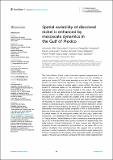Por favor, use este identificador para citar o enlazar a este item:
http://hdl.handle.net/10261/337488COMPARTIR / EXPORTAR:
 SHARE SHARE
 CORE
BASE CORE
BASE
|
|
| Visualizar otros formatos: MARC | Dublin Core | RDF | ORE | MODS | METS | DIDL | DATACITE | |

| Título: | Spatial variability of dissolved nickel is enhanced by mesoscale dynamics in the Gulf of Mexico |
Autor: | Félix-Bermúdez, Armando; Delgadillo-Hinojosa, Francisco; Lares, María Lucila; Torres-Delgado, Eunise Vanessa; Huerta-Díaz, Miguel A.; Tovar-Sánchez, Antonio CSIC ORCID ; Camacho-Ibar, Víctor Froylan | Palabras clave: | Dissolved nickel Gulf of Mexico Loop current Macronutrients Mesoscale eddies Tropical Atlantic Central Water |
Fecha de publicación: | 6-ene-2023 | Editor: | Frontiers Media | Citación: | Frontiers in Marine Science 9:1036331 (2023) | Resumen: | The Gulf of Mexico (GoM) is one of the most dynamic marginal seas in the world owing to the intrusion of the Loop Current and the shedding of anticyclonic eddies (LCE) that travel westward across the Gulf. However, the impacts of these mesoscale dynamics on the supply and removal of bioessential trace metals in surface waters remain unclear. We study the impact of mesoscale eddies on the distribution of dissolved nickel (Ni), a biologically active element scarcely studied in the region. The vertical distribution of Ni was determined in the deep-water region of the GoM during summer of 2017, when two anticyclonic LCE (Quantum and Poseidon) were present. Nutrient-like profiles of Ni in the GoM resemble those from the Atlantic Ocean, but they showed high spatial variability within the first 1000 m, which was associated with the impact of mesoscale eddies. Similarly to subtropical gyres, macronutrients were almost depleted in surface waters, while Ni never fell below 1.51 nmol kg-1, suggesting low Ni lability or alternatively, slow biological uptake compared to that of macronutrients. In particular, lowest levels of Ni and macronutrients (PO4 and NO3) were recorded in surface waters of the anticyclonic eddies and the Loop Current area. Anticyclonic LCEs deepened these Ni-poor waters pushing the Ni-rich core of Tropical Atlantic Central Water up to 600 m, whereas its shallowest position (up to 200 m) was recorded under cyclonic conditions in Campeche Bay. This eddy-induced vertical displacement of water masses also affected the integrated Ni and macronutrient concentrations in the upper 350 m but without modifying their stoichiometries. We suggest that a significant decrease in surface inventories of Ni and macronutrient in areas impacted by LCEs is a consequence of the trapping of the water within eddies, the biological uptake of Ni and macronutrients combined with their limited replenishment from below, which likely affects autotrophic groups. In conclusion, the mesoscale dynamic permanently present in the GoM play an important role in modifying the vertical distribution of Ni and macronutrients as well as their availability in the upper water column of this marginal sea. | Versión del editor: | https://doi.org/10.3389/fmars.2022.1036331 | URI: | http://hdl.handle.net/10261/337488 | DOI: | 10.3389/fmars.2022.1036331 | E-ISSN: | 2296-7745 |
| Aparece en las colecciones: | (ICMAN) Artículos |
Ficheros en este ítem:
| Fichero | Descripción | Tamaño | Formato | |
|---|---|---|---|---|
| Spatial_variability_Felix_Bermudez.pdf | 62,91 MB | Adobe PDF |  Visualizar/Abrir |
CORE Recommender
Page view(s)
37
checked on 30-abr-2024
Download(s)
11
checked on 30-abr-2024
Google ScholarTM
Check
Altmetric
Altmetric
Este item está licenciado bajo una Licencia Creative Commons

